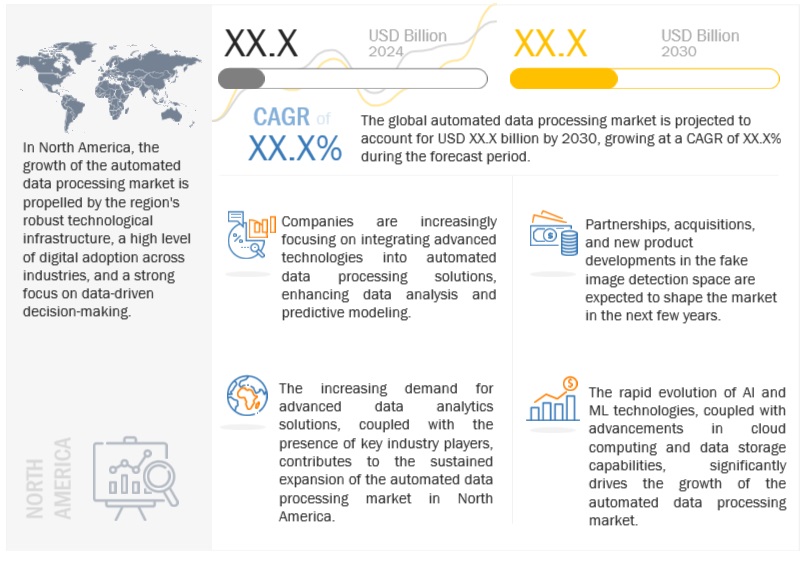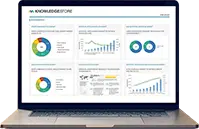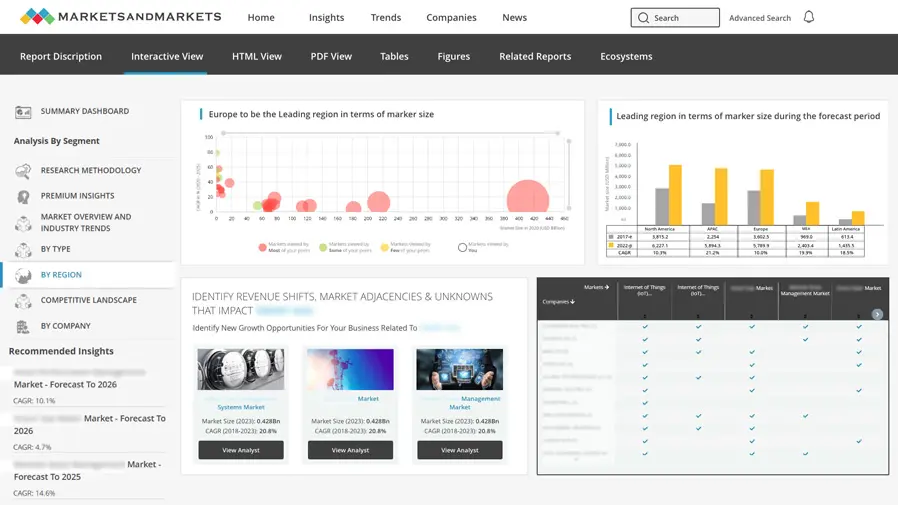Automated Data Processing Market - Global Forecast to 2030
The automated data processing market is currently witnessing remarkable growth, with projections indicating a substantial increase in market size. Estimates suggest a notable expansion from its value of USD XX.X billion in 2024 to USD XX.X billion by 2030, reflecting a robust CAGR of XX.X% over the forecast period. The growth of the automated data processing market is fueled by several critical factors, including the escalating volume and diversity of data generated, rising demand for advanced analytics and actionable insights, and the continual evolution of artificial intelligence and machine learning technologies. As organizations prioritize data-driven decision-making, the need for efficient data processing solutions intensifies, fostering the market's expansion.

To know about the assumptions considered for the study, Request for Free Sample Report
Market Dynamics
Driver: The surging demand for analytics and BI drives automated processing
The growing demand for data analytics and business intelligence (BI) is propelling the automated data processing market forward. In an era where data has become a keystone of decision-making across industries, organizations increasingly recognize the transformative power of harnessing insights from their data. Businesses actively seek ways to leverage advanced analytics and BI tools to uncover patterns, trends, and actionable intelligence within their datasets. Automated data processing solutions play a crucial role in meeting this demand by streamlining the processing of vast and complex datasets. These tools enable organizations to extract meaningful information, perform real-time analysis, and comprehensively understand their operations.
Restraint: The high implementation and maintenance costs hinder automated data processing adoption
Implementing and maintenance costs are significant restraints in the automated data processing market. While computerized solutions offer long-term efficiency gains, the initial investment required for acquiring and implementing these technologies can be substantial. Moreover, ongoing expenses related to system maintenance, updates, training, and support can contribute to the financial burden, especially for small and medium-sized enterprises (SMEs) with limited budgets. The perceived high cost of entry may impede the widespread adoption of automated data processing solutions, making it crucial for organizations to carefully assess the return on investment and consider scalable solutions that align with their budgetary constraints.
Opportunity: Advancements in AI and ML empower automated data processing for precise insights and automation
The rapid advancements in Artificial Intelligence (AI) and Machine Learning (ML) represent a transformative opportunity for the automated data processing market. Integrating sophisticated AI and ML algorithms into data processing systems enhances their capacity to analyze vast datasets, uncover intricate patterns, and facilitate intelligent automation. This opportunity allows vendors to develop cutting-edge solutions beyond traditional data processing, offering businesses more accurate insights and predictive capabilities. As AI and ML technologies evolve, the automated data processing market can harness their power to deliver innovative tools that significantly enhance data analytics, supporting organizations in making informed decisions and staying ahead in the competitive landscape.
Challenge: Integrating with legacy systems poses challenges in automated data processing
Integrating automated data processing solutions with legacy systems poses a significant hurdle for organizations seeking to modernize their data infrastructure. Older, legacy systems often operate on outdated architectures and may need more compatibility with the advanced technologies used in modern data processing software. This integration gap can lead to data silos, hindering seamless communication between different parts of the business. To address this challenge, companies can opt for custom automated data processing solutions designed to bridge the gap between legacy and modern systems. By strategically navigating integration challenges, organizations can unlock the full potential of automatic data processing while preserving the functionality of their existing technology investments.
Automated data processing Market Ecosystem

By offering, services segment is slated to witness the substantial growth rate during the forecast period.
The automated data processing market is witnessing a substantial growth rate, particularly in the services segment. Organizations increasingly recognize the value of outsourcing data processing tasks to specialized service providers. This trend is fueled by the need for expertise in handling complex data workflows, ensuring data quality, and implementing efficient data integration strategies. Service providers offer a range of solutions, including data labeling, annotation, and managed data services, enabling businesses to focus on their core operations while benefiting from specialized data processing capabilities. As the demand for tailored services continues to rise, the services segment is poised for remarkable growth in the evolving landscape of automated data processing.
By data source, image data to account for a significant market size during the forecast period.
In the automated data processing market, image data is anticipated to account for a substantial market size, reflecting the increasing importance of visual information across industries. The rise of applications in computer vision, facial recognition, and image-based analytics has fueled the demand for robust automated data processing solutions tailored to handle diverse image datasets. As businesses leverage image data for insights, decision-making, and innovative applications, the market for processing and analyzing this visual information is poised for substantial growth. Vendors offering advanced image processing capabilities, including image recognition and feature extraction, will likely play a vital role in shaping the landscape of automated data processing in response to the expanding requirements of image-centric applications.
By region, Asia Pacific is set to experience rapid growth rate during the forecast period.
The Asia Pacific region is poised to experience a rapid growth rate during the forecast period. This surge in growth can be attributed to increasing digitalization initiatives, the burgeoning adoption of advanced technologies, and a growing emphasis on data-driven decision-making across diverse industries in the region. Countries such as China, India, Japan, and South Korea are witnessing a surge in demand for automated data processing solutions as businesses strive to harness the potential of their expanding datasets. The dynamic economic landscape, coupled with a proactive approach towards technological innovation, positions the Asia Pacific region as a key player in driving the evolution of the automated data processing market in the foreseeable future.
Key Market Players
The automated data processing solution and service providers have implemented various organic and inorganic growth strategies, such as new product launches, product upgrades, partnerships and agreements, business expansions, and mergers and acquisitions to strengthen their offerings in the market. Some major players in the automated data processing market include Microsoft (US), AWS (US), IBM (US), Couchbases (US), and Salesforce (US), along with SMEs and startups such as Polymer (US), Nanonets (US), Airplane Labs (US), Multimodal (US), Thoughtful Automation (US).
Recent Developments:
- In October 2023, IBM acquired Manta Software Inc., a leading data lineage platform. This acquisition aims to enhance its capabilities within Watsonx.ai, Watsonx. Data, and Watson. Governance. It reinforces IBM’s commitment to enable businesses to develop products rooted in trust and transparency, aligning with these core principles.
- In September 2023, Oracle unveiled the Fusion Data Intelligence Platform, representing a cutting-edge data, analytics, and AI platform. This platform is tailored to assist Oracle Fusion Cloud Applications customers in achieving superior business outcomes by merging data-centric insights with intelligent decision-making and actionable steps.
- In May 2023, Qlik acquired Talend, broadening its top-tier capabilities for modern enterprises to manage, process, trust, analyze, and act upon data. The synergies between Qlik and Talend solutions complement each other, strengthening various critical aspects, including data quality, transformation, application connectivity, and API services.
- In May 2023, Microsoft unveiled Microsoft Fabric, an analytics platform designed to streamline data and analytics tools for organizations. This integrated solution merges technologies such as Azure Data Factory, Azure Synapse Analytics, and Power BI into a unified product. Fabric empowers data and business professionals to harness the full potential of their data, setting the stage for the era of AI while simplifying data-related workflows.
- In September 2022, Altair acquired RapidMiner, a leading advanced data analytics and machine learning software provider. This acquisition enhances Altair's existing end-to-end data analytics portfolio, combining RapidMiner's desktop and cloud platforms with Altair's capabilities and empowering customers to comprehend, transform, act on, and automate their data effectively.
Frequently Asked Questions (FAQ):
What is automated data processing?
Automated data processing involves utilizing computer systems and software to manage, process, and transform data efficiently with minimal human intervention. This streamlined approach accelerates data handling, mitigates errors, and improves overall data quality by reducing reliance on manual efforts.
What is the total CAGR expected to be recorded for the automated data processing market during 2024-2030?
The automated data processing market is expected to record a CAGR of XX.X% from 2024-2030.
Which are the major growth enablers catalyzing the automated data processing market?
The major growth enablers propelling the automated data processing market include the exponential growth of data volumes, heightened demand for real-time analytics and business intelligence, and advancements in artificial intelligence and machine learning technologies. As businesses recognize the value of efficient data processing, the need for streamlined automation solutions continues to surge, driving innovation and adoption across industries.
Which are the key solutions prevailing in the automated data processing market?
Natural language processing, video analytics, speech and voice recognition, image recognition, and graph analytics.
Who are the key vendors in the automated data processing market?
Some major players in the automated data processing market include Microsoft (US), AWS (US), IBM (US), Couchbase (US), Salesforce (US), Oracle (US), Akkio (US), MonkeyLearn (US), Databricks (US), Hewlett Packard Enterprise (US), Splunk (US), Altair (US), Sisense (US), Knime (Switzerland), Qlikview (US), Twilio (US), Cogito (US), Twilio (US), Automation Anywhere (US), Alteryx (US), UiPath (US). .
To speak to our analyst for a discussion on the above findings, click Speak to Analyst
















Growth opportunities and latent adjacency in Automated Data Processing Market